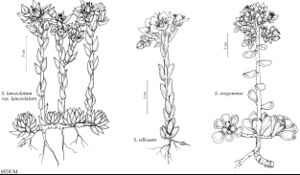Sedum oregonense
Man. Higher Pl. Oregon, 361. 1941,.
Herbs, perennial, cespitose or not, glabrous. Stems rhizomes, horizontal, much-branched, bearing rosettes. Leaves alternate, ascending to spreading, sessile to subsessile; blade green, glaucous, not strongly pruinose, obovate or oblanceolate, subterete, 10–36 × 5–16 mm, base not spurred, not scarious, apex emarginate to retuse. Flowering shoots erect, simple, (6–)10–28 cm; leaf blades suborbiculate or obovate, base not spurred; offsets not formed. Inflorescences panicles, 10–120-flowered, 3–20-branched; branches not recurved, dichotomously forked; bracts similar to leaves, smaller. Pedicels 2–5 mm. Flowers 5-merous; sepals (persistent, closely appressed to corolla tube), erect, connate basally, greenish, ovate, equal, 3.2–3.5 × 1–3 mm, apex subacute; petals (persistent until fruiting), erect basally, divergent apically, connate basally, creamy white, yellowish white, or pale yellow, elliptic-oblong or oblanceolate-oblong, cucullate, 5–9(–11.5) mm, apex abruptly pointed; filaments pale yellow; anthers yellow; nectar scales white or yellow, subreniform. Carpels erect in fruit, distinct, brown, (strongly 5-veined). 2n = 90.
Phenology: Flowering spring–summer.
Habitat: Gravel, mats of Selaginella or moss on rocky slopes and ledges, crevices of cliffs
Elevation: 900-2200 m
Discussion
Selected References
None.

